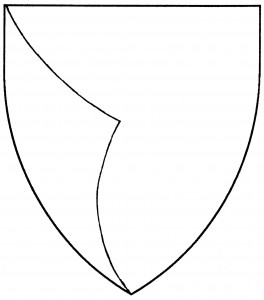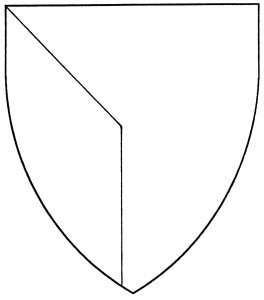A gore is considered an heraldic sub-ordinary by some texts, and a rebatement of honor by others; it seems to be an invention of heraldic writers. Certainly, no instance of its actual use in period armory has yet been documented – but as it was described in period tracts (e.g., Legh’s Accidence of Armory, 1562 [72v]), the gore has been accepted for use in Society heraldry.
The gore may issue from either the dexter or the sinister side of the shield; the default gore issues from dexter. Society armory has examples where both gores are used; this has been deemed a step from period practice.
The “gusset” is an artistic variant of the gore, which is drawn with straight lines instead of curved lines. Actual instances of its use have been documented in Scots heraldry, in the arms of Cunningham, 1610 [Guillim1 35]; however, unlike the gore, gussets were found in pairs.
Charged gores and gussets are now allowed in Society armory, though their use is deemed a step from period practice. The use of other charges on the field alongside a gore or gusset is likewise a step from period practice. See also ordinary.
Regulus of Vinhold bears: Or, two gores sable.
Thora Arnketilsdottír bears: Sable, a gore sinister vair.
Sarah of the Crystal Water bears: Argent, two gussets nebuly inverted azure, each charged with a gout argent.

